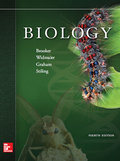
Concept explainers
Where do the pollen grains of flowering plants develop?
- a. in the anthers of a flower
- b. in the carpels of a flower
- c. while being dispersed by wind, water, or animals
- d. within ovules
- e. within pistils
Introduction: The flowering plants are categorized under the group of “angiosperms”. The male reproductive system is called “stamen”. However, the female reproductive system is known as “pistil or carpel”. Pollen grains represents male gametophyte and ovule represents female gametophyte.
Answer to Problem 1TY
Correct answer: The pollen grains of the flowering plants develop “in anthers of the flower”. Hence, the correct answer is option a.
Explanation of Solution
Reason for correct answer:
The male reproductive part of the flower is stamen or androecium. Stamen is differentiated into filament and anther at the tip. The formation and development of pollen grains take place in the anther of the stamen.
Option a. is given as “in the anthers of a flower”.
In the anthers of the flower, the development of the pollen grains takes place. Hence, the correct answer is option a.
Reason for incorrect answer:
Option b. is given as “in the carpels of a flower”.
Carpel represents the female reproductive system, which bears female gametophyte and not the male gametophyte. Hence, option b. is incorrect.
Option c. is given as “while being dispersed by winds, water or animals”.
After the formation of pollen grains, it dispersed by winds, water, or animals. This process takes place after the development of pollen grains. Hence, option c. is incorrect.
Option d. is given as, “within ovules”.
The ovules represent the female structure of the female reproductive system of the flower. It gets fertilized by means of pollen grains. Thus, the formation of pollen grains does not takes place inside the ovules. Hence, option d. is incorrect.
Option e. is given as “within pistil”.
Pistil represents the female reproductive system of the flower and it contains ovules. Thus, the development of the pollen grains cannot be possible in pistil. Hence, option e. is incorrect.
Hence, the options b., c., d., and e. are incorrect.
The development of anthers takes place in the anther of a flower.
Want to see more full solutions like this?
Chapter 39 Solutions
EBK BIOLOGY
Additional Science Textbook Solutions
Genetics: From Genes to Genomes
Laboratory Manual For Human Anatomy & Physiology
SEELEY'S ANATOMY+PHYSIOLOGY
Physical Universe
Microbiology Fundamentals: A Clinical Approach
Human Physiology: An Integrated Approach (8th Edition)
- What are Clathrin coated vesicles and what is their function?arrow_forwardHow is a protein destined for the Endoplasmic Reticulum (ER), imported into the ER? Be concise.arrow_forwardFind out about the organisations and the movements aimed at the conservation of our natural resources. Eg Chipko movement and Greenpeace. Make a project report on such an organisation.arrow_forward
- What are biofertilizers and mention the significancearrow_forwardPCBs and River Otters: Otters in Washington State’s Green-Duwamish River have high levels of polychlorinated biphenyls (PCBs) in their livers. PCBs can bind to the estrogen receptors in animals and disrupt the endocrine system of these otters. The PCBs seem to increase the estrogen to androgen ratio, skewing the ratio toward too much estrogen. How would increased estrogen affect the river otter population? Based on your reading of the materials in this unit, what factors can affect fertility in humans? Explain how each of the factors affecting human fertility that you described can disrupt the human endocrine system to affect reproduction.arrow_forwardOther than oil and alcohol, are there other liquids you could compare to water (that are liquid at room temperature)? How is water unique compared to these other liquids? What follow-up experiment would you like to do, and how would you relate it to your life?arrow_forward
- Selection of Traits What adaptations do scavengers have for locating and feeding on prey? What adaptations do predators have for capturing and consuming prey?arrow_forwardCompetition Between Species What natural processes limit populations from growing too large? What are some resources organisms can compete over in their natural habitat?arrow_forwardSpecies Interactions Explain how predators, prey and scavengers interact. Explain whether predators and scavengers are necessary or beneficial for an ecosystem.arrow_forward
- magine that you are conducting research on fruit type and seed dispersal. You submitted a paper to a peer-reviewed journal that addresses the factors that impact fruit type and seed dispersal mechanisms in plants of Central America. The editor of the journal communicates that your paper may be published if you make ‘minor revisions’ to the document. Describe two characteristics that you would expect in seeds that are dispersed by the wind. Contrast this with what you would expect for seeds that are gathered, buried or eaten by animals, and explain why they are different. (Editor’s note: Providing this information in your discussion will help readers to consider the significance of the research).arrow_forwardWhat is the difference between Uniporters, Symporters and Antiporters? Which of these are examples of active transport?arrow_forwardWhat are coupled transporters?arrow_forward

 Biology (MindTap Course List)BiologyISBN:9781337392938Author:Eldra Solomon, Charles Martin, Diana W. Martin, Linda R. BergPublisher:Cengage Learning
Biology (MindTap Course List)BiologyISBN:9781337392938Author:Eldra Solomon, Charles Martin, Diana W. Martin, Linda R. BergPublisher:Cengage Learning Concepts of BiologyBiologyISBN:9781938168116Author:Samantha Fowler, Rebecca Roush, James WisePublisher:OpenStax College
Concepts of BiologyBiologyISBN:9781938168116Author:Samantha Fowler, Rebecca Roush, James WisePublisher:OpenStax College Biology Today and Tomorrow without Physiology (Mi...BiologyISBN:9781305117396Author:Cecie Starr, Christine Evers, Lisa StarrPublisher:Cengage Learning
Biology Today and Tomorrow without Physiology (Mi...BiologyISBN:9781305117396Author:Cecie Starr, Christine Evers, Lisa StarrPublisher:Cengage Learning Biology: The Dynamic Science (MindTap Course List)BiologyISBN:9781305389892Author:Peter J. Russell, Paul E. Hertz, Beverly McMillanPublisher:Cengage Learning
Biology: The Dynamic Science (MindTap Course List)BiologyISBN:9781305389892Author:Peter J. Russell, Paul E. Hertz, Beverly McMillanPublisher:Cengage Learning Biology 2eBiologyISBN:9781947172517Author:Matthew Douglas, Jung Choi, Mary Ann ClarkPublisher:OpenStax
Biology 2eBiologyISBN:9781947172517Author:Matthew Douglas, Jung Choi, Mary Ann ClarkPublisher:OpenStax





